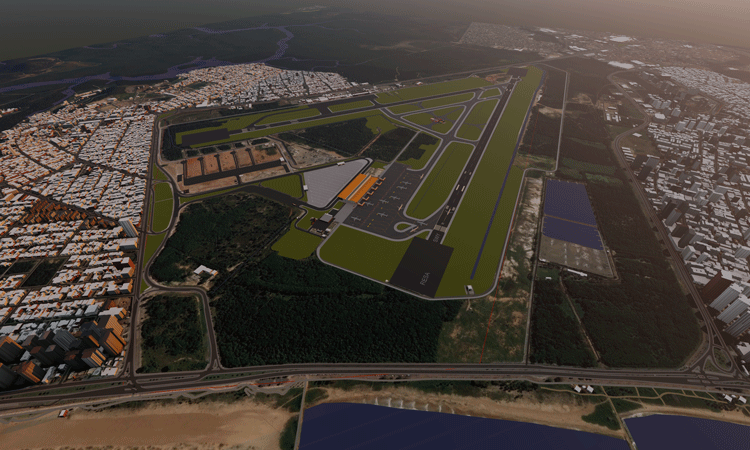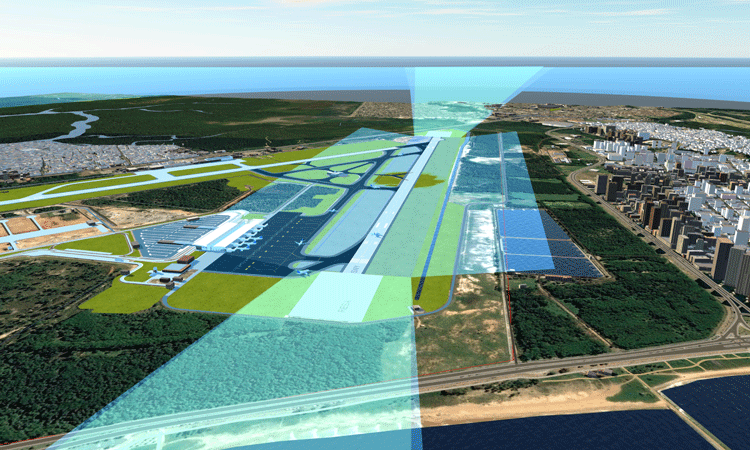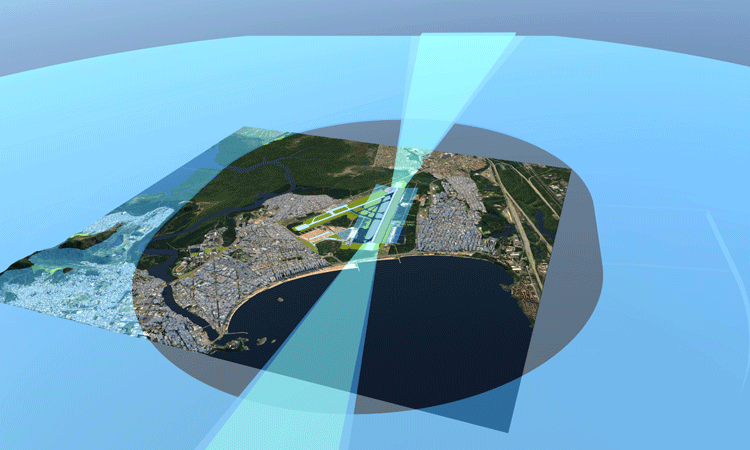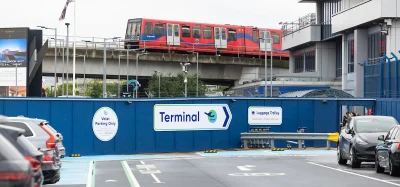Challenges and future perspectives related to increasing environmental performance at airports in the context of digital transformation
Posted: 16 April 2024 | Guilherme Guignone | No comments yet
For International Airport Review, MSc. Guilherme Guignone, BIM Coordinator, Architect and Digital Transformation Leader at the Brazilian Airport Infrastructure Company – INFRAERO, discusses the new challenges and perspectives with the increasing emergence of strategies for digitalising processes in airport activities and the urgent demands in relation to mitigating environmental impacts at airports.


Figure 1 – Airport modelling carried out by BIM platforms. Vitória Airport, Espírito Santo, Brazil. Source: Guilherme Guignone
Future airport engineering projects must combine aesthetic, operational, safety and maintainability assumptions with environmental performance. The main difference in the way infrastructure is designed today for the future is the attention that must be given to environmental issues. The construction sector is currently responsible for one third of global energy consumption and, if the situation does not change, energy demand for buildings will increase by 50% in 2050 (Shim et al., 2020).
At the same time that technological advances have managed to mitigate environmental impacts during the operational phase of airport facilities and passive architecture has been increasingly considered, increasing the energy efficiency of buildings, it will also be essential to select materials and systems that mitigate the environmental impacts arising from its manufacturing, transportation and installation. Those materials that, for example, produce less embodied energy and CO2 emissions during their lifecycle. Embodied energy is a calculation of all the energy that is used to produce a material or product, including extraction, manufacturing, and transportation. The trend is to increasingly use the Lifecycle Assessment Methodology – LCA; ISO 14040 and ISO 14044 standards; to quantify environmental impacts in the initial stages of airport engineering projects, using it as a decision-making tool for less impactful choices.
Predictability and waste
Also noteworthy in airport projects aimed at mitigating environmental impacts, are solutions related to optimising construction planning, integrating project execution planning with engineering design initiatives, enabling construction with less unpredictability and waste and better performance in execution, considering organisation of processes, arrangement of materials and logistics of equipment and people and strategies to meet the execution schedule. All this while maintaining essential operations and necessary security requirements in the airport environment.
Join us live: Shaping the Next Generation of Hold Baggage and Air Cargo Screening
Join us live for an insightful webinar on 11th December at 14:00 GMT, in collaboration with Smiths Detection, as we explore the strategic balance of operational efficiency, regulatory compliance, and sustainability in high-volume security environments.
This session offers a focused look into future-proofing your security strategy.
Key learning points
- Cost Reduction: Strategies to minimize bag travel time while simultaneously reducing operational costs.
- Regulatory Roadmap: Insights into the next wave of regulatory changes and their impact on future investment decisions.
- Sustainable Systems: Practical approaches to building sustainability into security systems and lowering the total cost of ownership (TCO).
- Scalable Solutions: Real-world examples of scalable systems supporting current airport growth and preparing for tomorrow.
Register now for expert insights, case studies, and actionable strategies on operational efficiency!
Airports of the future will need to have BIM Methodology implemented, considering the entire lifecycle of the asset, integrating environmental data and enabling the appropriate selection of systems in the design and operation phase. Furthermore, they will have BIM integrated into the geographic information system and the use of augmented reality and virtual reality. Elements of Industry 4.0 will also be incorporated, such as: BIM Data and the Internet of Things (IoT).
Digital twins
There will be the physical asset and its digital twin, sending real-time responses from environmental monitoring and control systems and maintenance management to all airport stakeholders. Even though some of these requirements already occur in some airports today, what is expected in the future is the democratisation of these uses in airports around the world, allowing global integration between airports, increasing security aspects, reformulating processes and performance standards and allowing comparison tools through lessons learned.
Other situations worth highlighting are: even more efficient aerodrome configurations, combining operational efficiency with the optimisation of aircraft waiting and taxiing times, enabling lower CO2 emissions; airport buildings including the management of water resources and the waste management plan integrated with BIM implementation and execution of engineering projects in VDC (Virtual Design and Construction) where BIM is just one of the integral elements.
Finally, it is undeniable, they will continue to excel in the aesthetics and symbolic contribution they add to cities, in addition to lower impacts, in terms of environmental management, noise production and urban mobility. The city and airport interface will become increasingly fluid, organic and friendly.
Below, I highlight five relevant items that should be considered when designing airports in terms of mitigating environmental impacts and new digital transformation processes.
1: Use of VDC at airports
One of the concerns in environmental management at airports is mitigating the production of waste and the duration of works execution. An important way to increase efficiency in the process of executing engineering works, reducing rework and construction waste, is the use of the Virtual Design and Construction (VDC) methodology. The use of BIM only provides the execution of components in a VDC model and does not include the interaction between construction, organisation and work process. On the other hand, VDC aligns new BIM-based technologies to rethink work processes to achieve the highest efficiency in designing and building projects (Kunz and Fischer, 2020).
In addition to BIM, VDC uses other methodologies, such as ICE (Integrated Concurrent Engineering) and PPM (Product Production Management). The first seeks to avoid the traditional way of executing and planning engineering projects, where disciplines have a certain sequence of action, and only start to follow their products, and not their processes. It seeks to conduct projects in an integrated and simultaneous manner, in order to provide rapid resolution of conflicts and decision-making. It is implemented right at the beginning of the project, as it allows all disciplines to design together, which facilitates communication between areas. The second methodology is based on process management and aims to understand each and every project as a manufacturing process, thus defining its final products, raw materials, information and labour necessary for its operation sequence.
VDC models are designed to provide access to a project’s shared data for its owners, architects, engineers, contractors, and beneficiaries. Furthermore, VDC models are able to predict project performance and compare it with measured performance (Fosse, Ballard, Fischer, 2017). The use of Virtual design and construction (VDC) in airport projects and works is still timid in the world. The tendency is for methodologies like this to be absorbed in search of an inevitable future need, or obligation, to rationalise and organise construction activities and, as a consequence, mitigate environmental impacts.


Figure 2 – Modelling carried out by BIM platforms of obstacle-free surfaces at an airport. Vitória Airport, Espírito Santo, Brazil. Source: Guilherme Guignone
2: Integration BIM and Lifecycle Assessment – LCA in BIM implementations at airports
Life-cycle Assessment – LCA emerges as a relevant option to quantify the environmental impacts of a construction throughout its lifecycle, providing objective tools so that the construction sector can propose effective solutions to contribute to the mitigation of environmental impacts. LCA was developed in the mid-1980s and has developed and matured over the past few decades (Gustavsson, Joelsson, 2020). The methodology evaluates the environmental impacts of a product, process or activity. Through the lifecycle assessment process, energy and material uses are identified and quantified throughout the product’s entire lifecycle, including extraction, processing, manufacturing, transportation, use, reuse, maintenance, recycling or final disposal (Basbagill et al., 2013).
However, LCA in the environmental assessment of buildings remains a challenge, as it is still considered a complicated method due to the numerous barriers identified, such as: complexity, little knowledge of environmental impacts, excessively complicated calculations, among others (Jusselme et al., 2018). Aiming to reduce some of the barriers in using LCA for construction, the use of the BIM methodology can be a good option. With the methodology, designers may be able to reduce uncertainties related to the construction process to adopt LCA as a decision-making tool. The use of LCA and BIM integration in airport projects is beneficial as it improves the environmental assessment of airport facilities in the design phase and can mitigate the challenges of the conventional LCA process, which is time-consuming, costly and involves manual data entry. According to Shadram et al. (2018), there are four main benefits of BIM-LCA integration:
- a) avoiding manual data entry
- b) allow real-time evaluation
- c) improve building-wide assessments
- d) implement user-friendly analysis interfaces.
There are several approaches to integrating BIM with LCA. Each of them has benefits and negative points. The choice of which methodology to adopt must be made considering several issues. An analysis solely involving the best performance of the solution may not be effective. To select a certain approach, it may be necessary to consider, for example, the feasibility of acquiring specific software, such as, for example, the use of plugins in a certain authoring model. Certain plug-ins are only possible for certain BIM Platforms. The office may not have such platforms in its technology park. Or even, the need to use visual programming, requiring advanced knowledge to formulate scripts.
The potential and difficulties of adopting each approach must be assessed considering at least the three fields of the BIM methodology: tools, processes and people. Another important barrier is the lack of information about the LCA methodology. Therefore, when implementing BIM in an organisation, knowledge regarding this topic should also be provided. Thinking about the three fields of the BIM methodology (people, processes and tools) the people field needs to be carefully evaluated, with training and motivational strategies. I recently published an article presenting the production of research involving BIM and LCA integration, it was noted that the largest amount of research produced was between the years 2020 and 2022, representing more than 70% of the total published (Guignone, et al., 2022). Therefore, this is a subject that has required recent significant research and discussion efforts.
3 : Analysis of embodied energy added to operational energy at airports
Among other important themes in the integration of BIM and LCA is that, although traditionally the impacts of buildings are greater during the operational phase due to the energy demands of building systems, however the relationship between embodied energy of materials and operational energy is changing. New constructions have shown lower energy demand during the operational phase. Something important to also explore, already covered in some articles, but of high importance, is to contemplate analyses of embodied energy and the use and operation of enterprises, evaluating energy efficiency through computational tools.
Thus, it is possible to assess a balance between operational and embodied energy during the project development process. Many of the solutions to increase energy efficiency, for example: use of thermoacoustic materials, tend to increase the built-in load of the building or infrastructure components. Something also little explored in research involving the use of BIM and LCA are solar protection system solutions in buildings. These passive systems, when properly designed, tend to reduce the thermal load inside buildings. The analysis of embodied energy with the addition of protection devices and the reduction of air conditioning measures needs to be considered.


Modelling carried out by BIM platforms of obstacle-free surfaces at an airport. Vitória Airport, Espírito Santo, Brazil. Source: Guilherme Guignone
4: Waste management and use of construction waste at airports
Airports produce large volumes of waste for operational and maintenance activities. There is aircraft waste, generated by people and waste resulting from expansion and maintenance activities of airport infrastructure. For construction activities, it is often necessary to use large volumes of concrete for the construction of aircraft aprons and other rigid pavements and for the construction of airport buildings. It is interesting to envisage solutions to replace, even partially, impactful materials with materials with a lower environmental impact.
Some research demonstrates, for example, the use of Metakaolin (a component made from certain clays) and its potential to partially replace cement, obtaining a lower environmental impact. Cement, for its manufacture, requires the use of natural resources and the burning of limestone at high temperatures, generating high CO2 emissions. Metakaolin presents the burden of using natural resources, but a much lower burning temperature is required for its manufacture than that required for the manufacture of cement. However, if we associate materials that would potentially be discarded, overloading landfills, with the partial replacement of cement and maintaining the performance of concrete, we would have gains in both aspects. Therefore, it is important to think, mainly, about uses in infrastructure, where there is the consumption of large volumes of natural resources, the use of materials with a lower environmental impact. However, after the ‘discovery phase’, where the potential for mitigating the impacts of the materials to be incorporated into the processes is known, a method must be provided for these to be presented as an option in the design phases.
Thus, the BIM and LCA integration, already mentioned, has an important role: integrating the tools for quantifying environmental impacts across the entire lifecycle of materials and systems into the engineering project development process. Providing assertive choices in the initial phases of the project and enabling incalculable environmental gains throughout the entire life cycle of an airport.
5: Reduction of CO2 emissions during aircraft transit on the ground
Finally, it is important to mention that, although technological advances have reduced CO2 emissions from aircraft, they still produce a considerable environmental impact. Rarely, runway and taxi configurations are designed with shorter taxiing and waiting times for aircraft in mind from the perspective of mitigating CO2 emissions. Since 1970, the global aviation industry has increased by an average of 5% per year. Civil aviation emissions have increased in line with greenhouse gas (GHG) emissions. International aviation has grown 87% since 1990, according to recent studies (ICAO, 2012; IATA, 2012). The growth in the annual rate of air traffic is still expected to be 4-5% in the coming years. There is a global consensus that aviation emissions cannot increase further after 2020, and that the aviation industry must reduce half of its global carbon dioxide emissions by 2050 compared to 2005 levels (IATA Carbon Offset and Reduction Scheme for International Aviation). Aircraft produce significant environmental impacts due to landing, take-off and taxiing. In recent years, scientific and technological research has focused on taxiing efficiency. For example, an A320 aircraft burns 5-10% of its fuel during taxiing, about 15% of the entire flight time (Nicolas, 2013). Studies have shown that different taxiing procedures (acceleration and deceleration rates during taxiing – Khadilkar and Balakrishnan, 2012) as well as taxiing strategies (Deonandan and Balakrishnan, 2010) could help reduce emissions and save fuel – savings that represent around 30% of the airline sector’s operating budget (Guo et al., 2014).
Therefore, it is also important to consider when designing geometric projects at airports the balance between infrastructure expansion, operational aspects and GHG emissions. I understand that this approach will be adopted across the world in airports of the future.
Conclusions
Future airport projects should seek to be even more efficient in terms of operational and safety requirements, mainly due to the reduction in available construction areas and the increase in aircraft traffic. At the same time, they will be required to achieve certain levels of mitigation of environmental impacts. These “cities” must assume their leading role in relation to the new paths that society must follow with regard to the construction industry and the technological universe. Just as the aviation industry has in its DNA the constant search to innovate and influence different sectors; with regard to operational, safety and aesthetic aspects; it should use its potential for our commitment to a more balanced and sustainable world.
References
GC Guignone et al. BIM and LCA integration methodologies: A critical analysis and proposed guidelines. Journal of Building Engineering. Volume 73, 15 August 2023
GC Guignone, GL Vieira, R Zulcão, MK Degen, SH de Moraes Mittri. Incorporation of glass powder and metakaolin as cement partial replacement to improve concrete mechanical properties and increase service life. Journal of Composite Materials 54 (21), 2965-2983
GC Guignone et al. Life Cycle Assessment of Waste Glass Powder Incorporation on Concrete: A Bridge Retrofit Study Case. Appl. Sci. 2022, 12(7)
Kunz, M. Fischer, Virtual Design and Construction: themes, Case Studies and Implementation Suggestions, (2012)
Kunz, M. Fischer, Virtual design and construction, Constr. Manag. Econ. 38 (2020) 355–363
Fosse, G. Ballard, M. Fischer, Virtual design and construction: aligning BIM and lean in practice, 25th Annual Conference of the International Group for Lean Construction (IGLC), 9-12 July 2017, Heraklion, Greece, 2017 https://apo.org.au/node/304973 (accessed May 31, 2021)
Shim, D. Song, J. Kim, The economic feasibility of passive houses in Korea, Sustainability 10 (10) (2018) 1–16
Gustavsson, A. Joelsson, Life cycle primary energy analysis of residential buildings, Energy and Buildings 42 (2) (2010)
Basbagill, J.; Flager, F.L.; Lepech, M.; Fischer, M. Application of Life-Cycle Assessment to Early Stage Building Design for Reduced Embodied Environmental Impacts. Build. Environ. 2013, 60, 81–92.
Jusselme, et al., An integrative approach for embodied energy: towards an LCA-based data-driven design method, Renew. Sustain. Energy Rev. 88 (2018) 123–132,
Shadram, F.; Johansson, T.D.; Lu, W.; Schade, J.; Olofsson, T. An integrated BIM-based framework for minimizing embodied energy during building design. Energy Build. 2018, 128, 592–604.
Baoquan Cheng; Kun Lu; Jianchang Li; Huihua Chen; Xiaowei Luo; Muhammad Shafique. Comprehensive assessment of embodied environmental impacts of buildings using normalized environmental impact factors Journal of Cleaner Production 334 (2022)
Vilches, A.; Garcia-Martinez, A.; Sanchez-Montañes, B. Life Cycle Assessment (LCA) of Building Refurbishment: A Literature Review. Energy Build. 2017, 135, 286–301


c: Guilherme Guignone
For more than 10 years, Guilherme Guignone has been a BIM Coordinator, Architect and Digital Transformation Leader at the Brazilian Airport Infrastructure Company – INFRAERO. In 2022, INFRAERO received the award for best project adopting Building Information Modelling – BIM, in one of the most relevant Brazilian awards in the use of BIM, BIM CREA Santa Catarina 2022. Guilherme Guignone was BIM Coordinator in this award-winning project. Guilherme Guignone is also a Professor, researcher and PhD candidate in Lifecycle Assessment (LCA) integration and Building Information Modelling – BIM. He is a BIM Specialist in Infrastructure from the University of Barcelona and Certified by the Airport Safety Professional Program by Airports Council International (ACI) and International Civil Aviation Organization (ICAO). Certified in Advanced Work Packaging (AWP) from AWP University.
The International Airport Summit is open for registration!
Date: 19 – 20 November 2025
Location: JW Marriott Hotel Berlin
At our flagship event of the year, we will dive into the future of airport operations, with expert-led sessions on passenger experience, innovative smart technologies, baggage handling, airside operations, data, security, and sustainability.
This is where global airport leaders come together to share insights, challenges, and real-world solutions.
Limited complimentary passes are available for eligible professionals – first come, first served!
Related topics
Airport development, Digital transformation, Emissions, Sustainability

















